Overview
The highlight of most tourists’ evenings in Taiwan must be visiting the local night market. The cacophony of sounds, the smells inundating your olfactory senses, the spectacular display of neon light signages vying for your visual attention against the night sky, followed up by the explosion of tastes in your mouth, is like no other experience. So, I was very excited when I heard that Taiwan Boardgame Design were prototyping a game called Taiwan Night Market.
Let me be honest upfront. As a board game, Taiwan Night Market is not close to the real thing. Well, maybe if they added a Scratch & Sniff portion on the game board in the future… In the meantime, the game is more like a teleportation machine for the mind. We are back at the market but now, the players are not tourists anymore. We are ambitious vendors making our fortune by bidding for the best locations and selling the right sort of food for patrons’ palates!
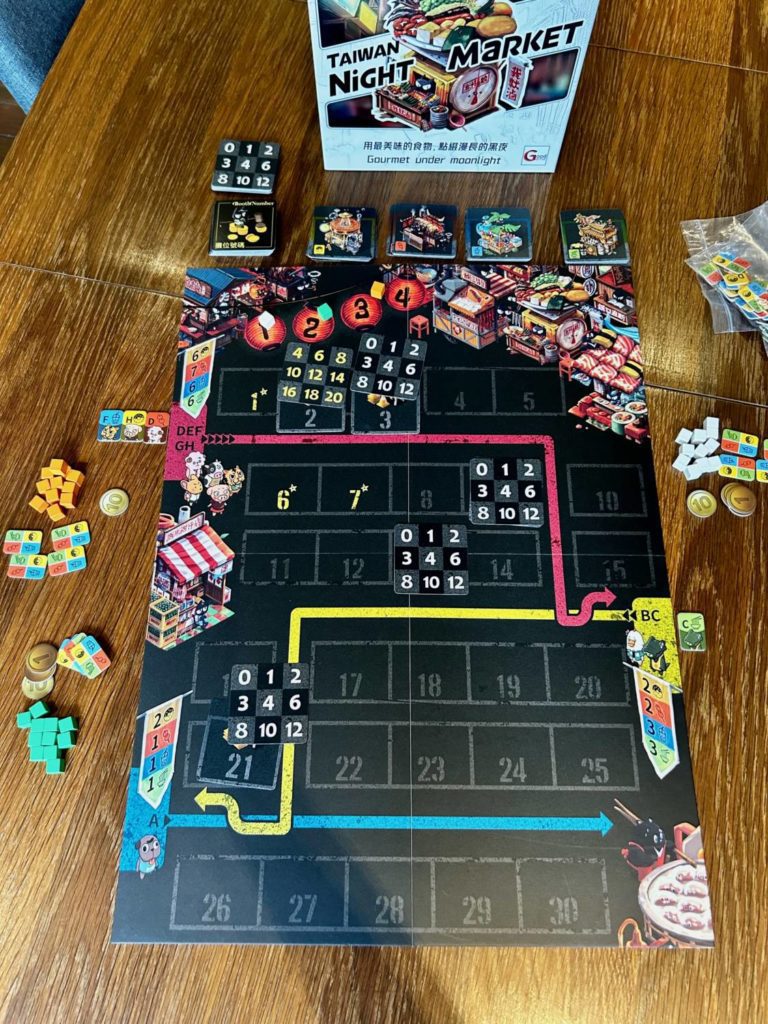
Set UP
Each player receives 12 player markers which they use to indicate their positions when bidding and on stall locations on the board. They also receive money in decreasing amounts determined according to the number of players. After the Customer tiles are shuffled, each player receives 4 tiles that they keep private. The rest of the Customer tiles form the Customer supply.
Stall cards are sorted into 4 piles—Drinks, Food, Desserts and Snacks—and are placed within reach of all players. The Location cards are also shuffled and placed in their corresponding numbers on the map. In a 3 player game, 6 locations are up for grabs. In a 4 player game, 5 locations will be up for bids.
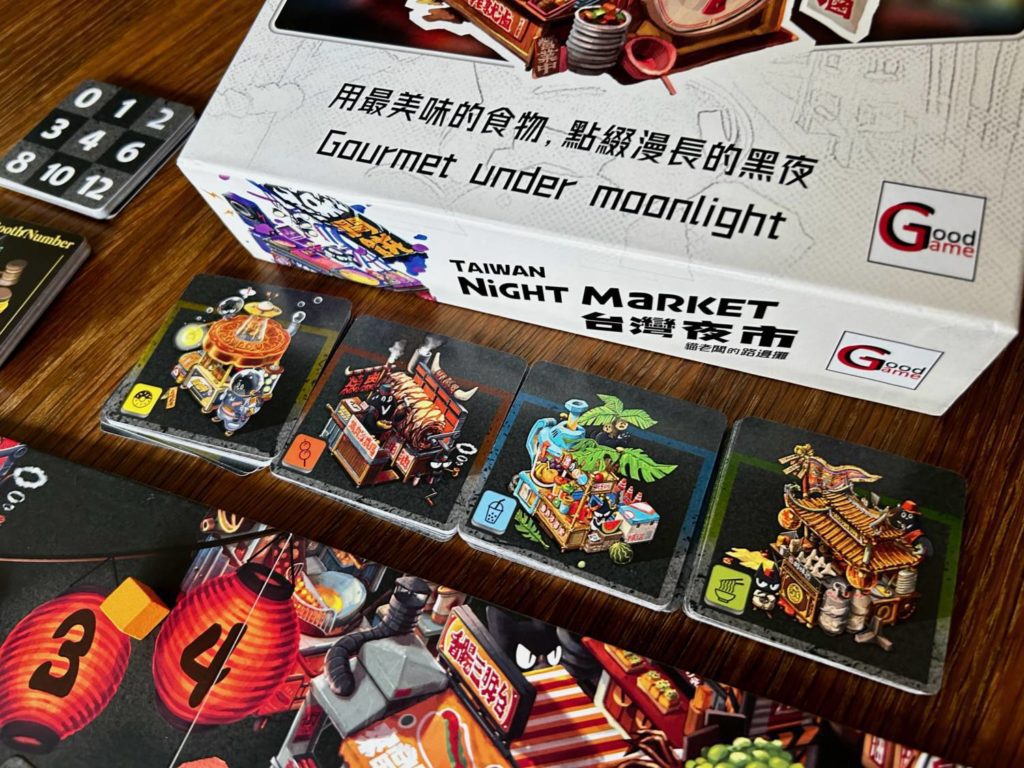
Game Play
The game is played over six rounds for a 3 player game and five rounds in a 4 player game. Each round consists of 12 stages.
In the first stage, new Location cards are revealed and placed on their corresponding number with Bidding cards stacked on top. Then, 4 random customers will be drawn from the Customer Supply pile. We found it easier to place the little Customer tiles in a reusable baggie and draw the requisite number instead of shuffling the little bits and keeping them stacked face down.
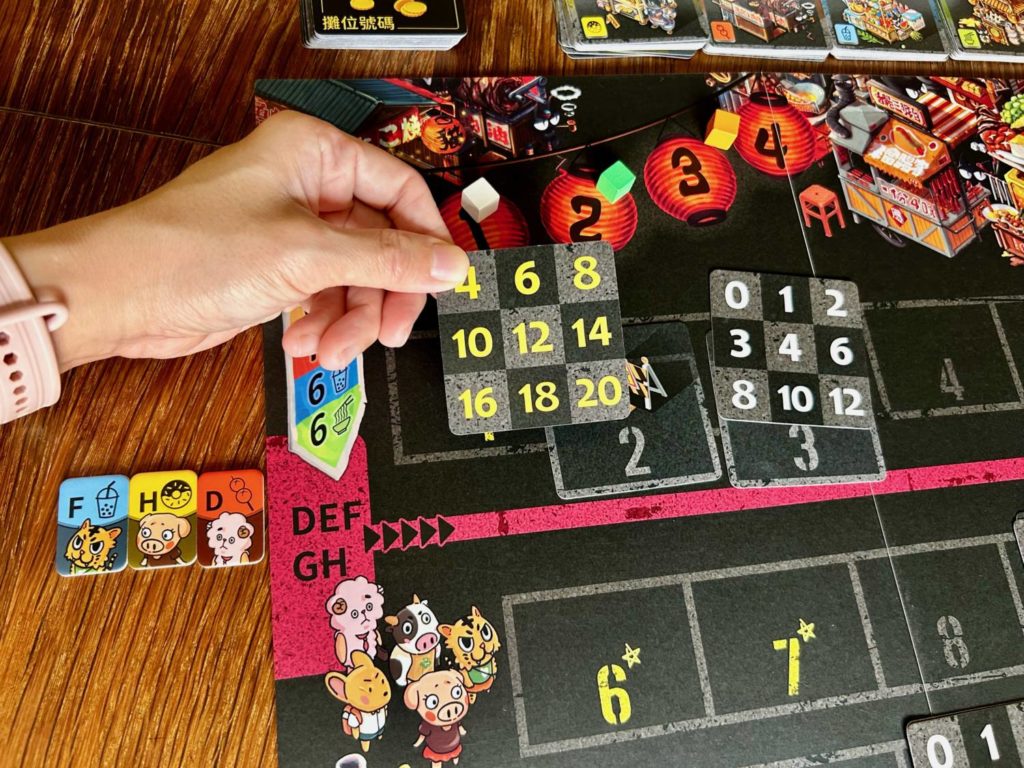
The Customer tiles indicate where they will enter the market, what food they are in the mood for, and in what order they will arrive. So in this example below, the customer will enter from the left gate since the letter D on the tile corresponds to the alphabet D indicated on the entrance. We also know that this customer is in the mood for snacks and that will help players determine what kind of food stall to open.
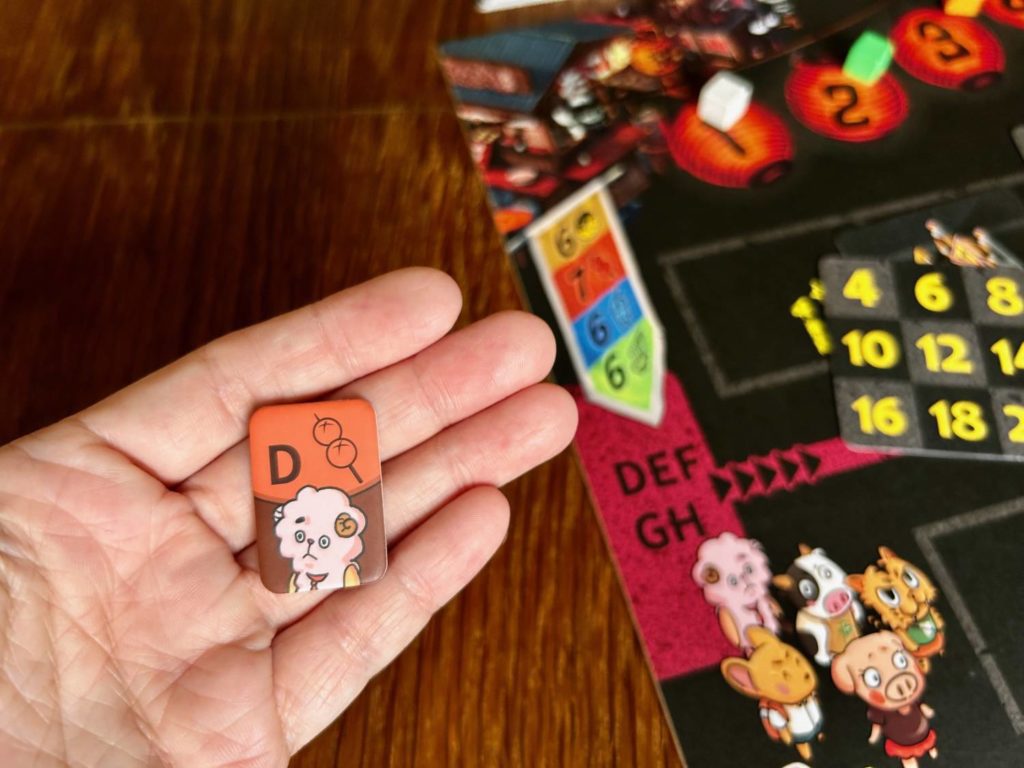
Next, each player gets the opportunity to sway the crowd. Players choose one or more of their own customers from their hand and place them face down in front of them. The number of tiles players choose is determined by which round is currently played. As with hip places to hang out, more and more customers start showing up toward the end of the night!
Now that each player knows who the customers are and what they want to eat, they can make decisions about stall locations and what they will sell.
Starting with the first player, each one takes turns to place their bids on the Bidding cards using their player markers until everyone has taken 2 turns and all players have won at least one location. If players choose not to bid, they may pass and end the rest of their bidding turns during the current round. If any player has been overbid and has not won any locations, they continue to bid an equal number of turns in player order until all players have won at least one location.
It is helpful to know that players may take up to 3 bank loans of $5 each, in order to qualify to bid or overbid their opponents if they do not have enough money on hand. If they do so, players must pay $7 to the bank at the end of the game.
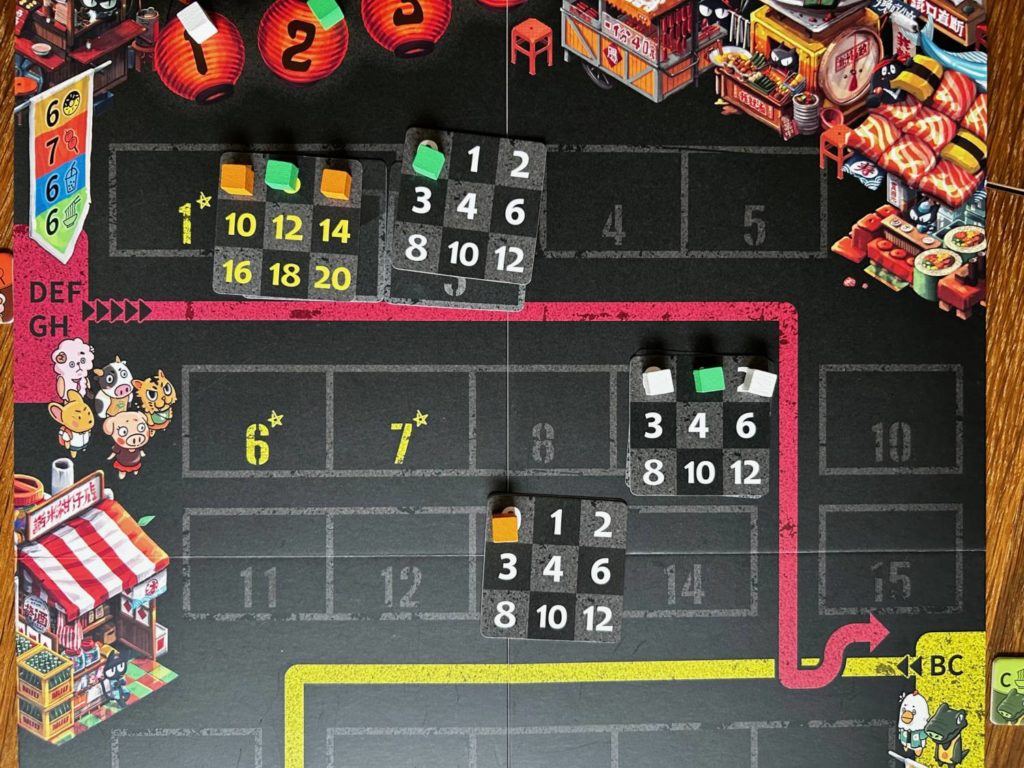
Once players have paid their bidding amounts to the bank, they may choose any of the four stall types to place at their locations. Then it’s time for the night market to open!
The customers enter the market from the various gates according to alphabetical order and just like in the real markets, their senses lead them to the first stall they see that sells what they want.
Since the stall holders can only attend to one patron at a time, the rest of the customers following behind will have to find the next available stall they want to patronize. If they find none, a customer is lost! They continue walking through the market and out of the gate at the other end.
Finally, after all customers have found their stalls, they each pay $3 to the stall-owner. If stall owners are entrepreneurial and expand the same business around the original stall in later rounds, customers pay an additional $1 for every stall orthogonally connected. After paying for their meals and eating their fill, the customer tiles are discarded.
Then once again, this 12-stage round is reset. Players draw back up to 4 customer tiles, new location cards are revealed, bidding cards laid out, 4 new random Customers will be drawn from the Customer supply pile and players select hidden customers of their choosing from their hand before the start of the next round. Player order is determined by the most number of stalls and then followed by the wealthiest player. If both are tied, then player order remains the same. At the end of the game, the player with the most money, after paying back any outstanding loans, is the winner of the game.

A Market Review
I like how some of the mechanisms mirror closely to real life market economics such as front-row stalls getting more footfall and attracting customers first, the economies of scale in owning a larger “chain” and earning more from each customer and how the number of customers increase later towards the evening. It took us a few games before we really got a feel of how those dynamics played out on the board.
Each round begins with the luck of the draw where stall locations were revealed so the approach to strategy is never very far reaching or set in stone. Players have to make the best out of which locations are made available. So, game strategy can vary drastically mid-game.
We made it a point to try this game a few times at 3 and 4 player counts. The game mechanics did feel different between the two. Even though the stalls available for purchase each round vary by the number of players, the customers to the market remain the same in the first 4 rounds whether it is 3 or 4 players. This meant that in a 4 player game, there is a tighter tension to securing the stalls in order to maximize the customer to stall ratio.
There is also a meaty tension between paying top dollar for prized locations (and possibly requiring more than one bank loan) or pivoting a strategy whilst not over drafting your cash in hand. In our games, it almost never paid out well to take more than one loan for hotly contested locations – and we did try with those very front-of-market stalls! Alas, our profits were not above the $4 or more to be paid in interest.
One of the things that surprised me was a missing catch-up mechanism that I expected to come through the player order determined at the end and start of each round. Player order is determined by the one with the most stalls and money. While that remains true to capitalism, it almost always advantaged those that were ahead since those who had more money could start, if not end, with higher bids on hot properties than players with a small bank account. This made the most impact in a 4-player game, when all the players were vying to cover the most real estate. So monopolizing space and stall types in the early rounds can make huge differences.

Since early advantages can have such a strong bearing mid-game, the game needs a strong catch-up mechanism to keep lagging players in the game. When the front of the market has been monopolized and all that are left are the back row stalls. These receive only 1-2 customers throughout the game, so there can be a defeatist vibe if you’re relegated to the back. It is a terrible advantage right to the final round scoring when bonuses are awarded for serving the most of one color.
The game does not feel long even though there are many stages of play thanks to the limited number of rounds. However, 12 stages in each round is still a lot of steps to play. That makes it quite a bit to remember which steps come first. Of course the order in which they are played makes sense but a handy player guide on the board would be helpful. Market locations take up most of the space on the board, and with location cards already being 2″ by 2″, it cannot really get any smaller. The only space left on the board are the corners with depictions of said stalls. Without room on the board to print a player aid, a handy card nearby for reference would be helpful.
Not much can be said regarding the quality since we received a prototype copy that will likely be improved on in actual production, but it was the detailed art work on each card that stood out to me. Different images on the stall types matter little to the actual game play. A green food card with a stall selling ramen and another selling Hot Pot makes no differences in play. Customers only select between the four types: food, drinks, sweets and street food. And yet, there are only two or three repeats of each kind of picture. Each image is a comical iconography of the stalls they represent and the amount of detail packed into each illustration is impressive. Take an example of the sushi restaurant stall card. In that little footprint, the artist has packed whole fish, sashimi slices, sushi rolls, hot green tea, noren signages, bar table and seating and managed to convey everything a sushi restaurant offers on the menu!
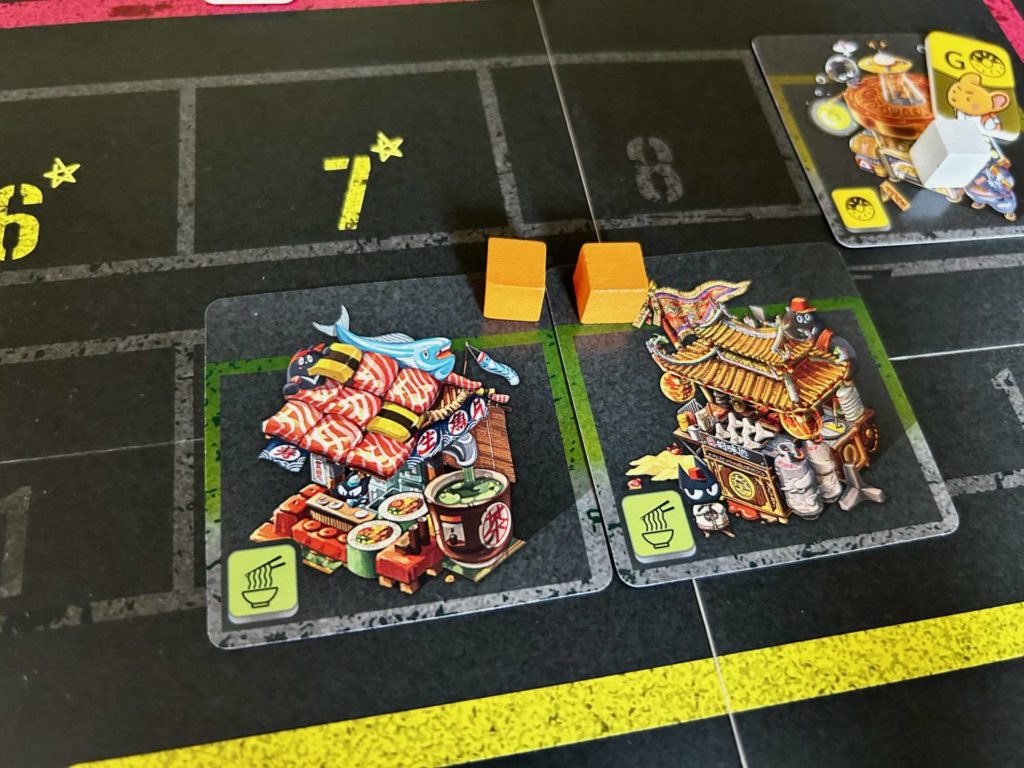
Overall, Taiwan Night Market is still great fun to play despite its shortcomings. None of them take away from the memories they elicit. As we awaken from our travel slumber in Asia, cultural and country themed games are gaining popularity. So, if you have visited Taiwan and enjoyed your night at the local night market, this game is sure to trigger your nostalgia. This is a fun mid-weight bidding and market economy game, right up the alley of those trying to make a quick buck.






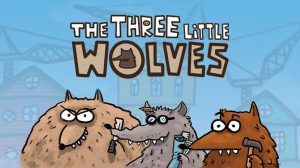




Add Comment